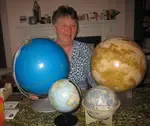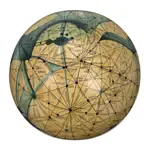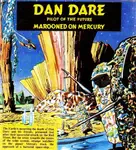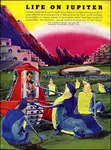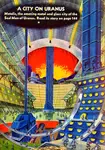- Home
- >
history of hopes
[ + links to: Atolls in the Lunar Seas - The Hunt for Vulcan ]
This page is intended to provide a timeline of hopeful conjecture, a non-fictional companion to Fictional Dates. Imagination and wishful thinking have surely played their colourful part in astronomy, strewing our mindscapes with hopes followed by disappointments. Blatant lies also, such as the Great Moon Hoax, have borne witness to our longing to believe in life and cultures on our neighbouring worlds.
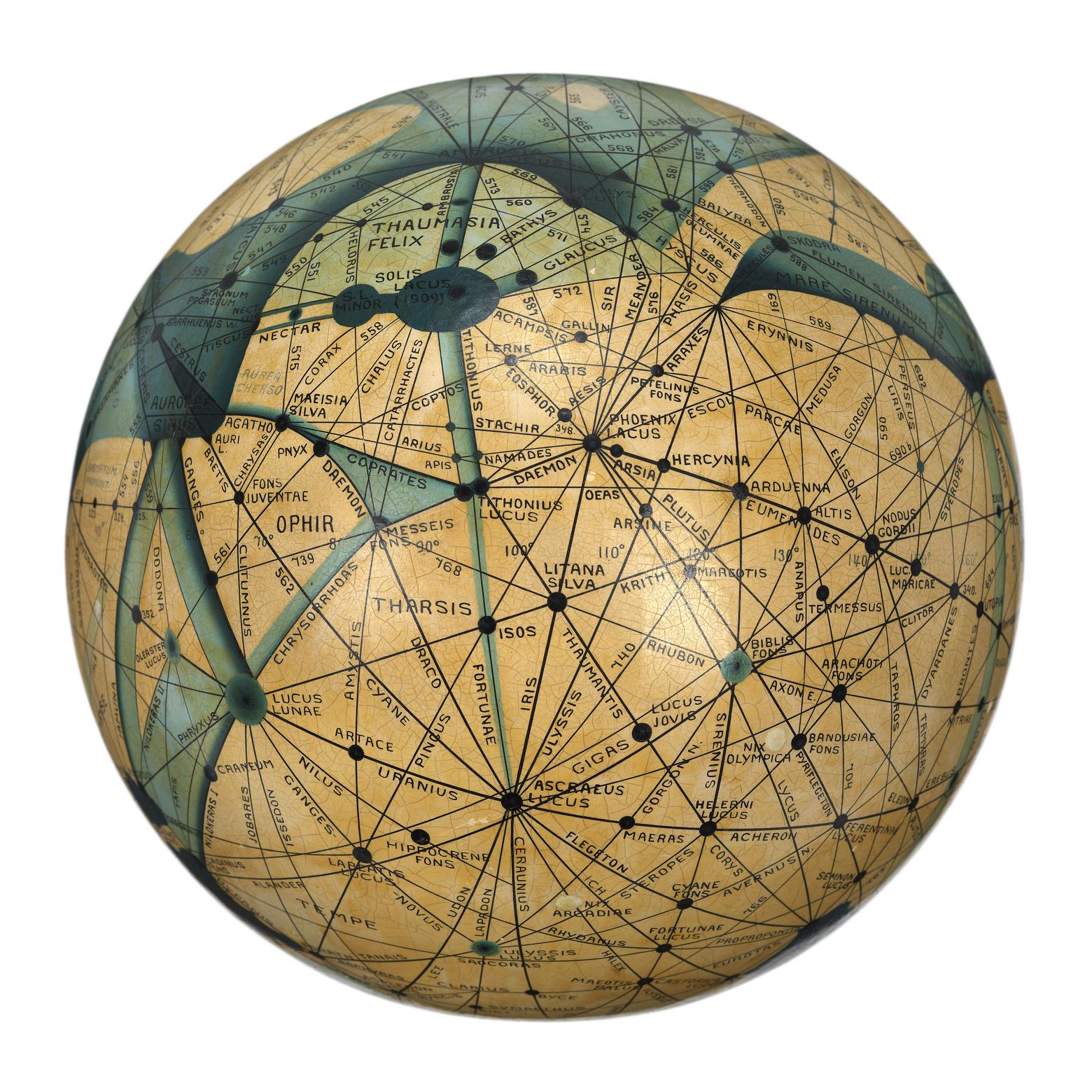
You may ask, with regard to all this disappointed belief: what use has it been? Here are three answers:
(1) The fiction boosted into life by old scientific notions is still with us, an imperishable trove of joy for the reader.
(2) Even at this late date (I'm writing this introduction on 23 February 2024) hope hasn't been abandoned for the discovery of extraterrestrial life in the Solar System. Efforts are still to be made, fuelled by motivation which is rather like a step-rocket: former stages have fallen away (e.g. Venus is a dead loss) but we can still ignite the next stage using the momentum of the previous one (e.g. we can look under the ice of Europa and Enceladus).
(3) The maddest and most long-term answer is to do with possibilities lurking in the far future, about which I've speculated elsewhere on the site: possibilities of reality engineering, of making dreams come true.
1440
Nicholas of Cusa advocates the existence of extraterrestrials in Of Learned Ignorance.
...It may be conjectured that in the area of the sun there exist solar beings, bright and enlightened intellectual denizens, and by nature more spiritual than such as may inhabit the moon...
[The Surprising History of Claims for Life on the Sun (2011)]
1621
Pages 475-7 of The Anatomy of Melancholy contain numerous references to the opinions of sages (for example Campanella, Tycho Braker, Kepler) regarding the inhabitants of other worlds.
...Tycho, in his Astronomical Epistles, out of a consideration of their vastity and greatness, ...will never believe those great and huge bodies were made to no other use than this that we perceive, to illuminate the earth, a point insensible, in respect of the whole...
1666
...In the very first volume of the Philosophical Transactions of the Royal Society of London (1665-66) appears an article entitled "Monsieur Azout's Speculations of the Changes, likely to be discovered in the Earth and Moon, by their respectives Inhabitants"....
Auzout's article starts by considering what changes in the Earth "supposed inhabitants of the Moon" might see...
Despite his evidence that water and air did not exist on the Moon, Auzout, like many other scientists of his time, still thought there might be inhabitants there, and he planned to build a 1,000-foot-long aerial telescope to search for them...
[Auzout: A Minor Crater and Some Big Ideas (2004)]
1686
Bernard le Bovier de Fontenelle (1657-1757) publishes his Entretiens sur la pluralité des mondes ("Conversations on the plurality of worlds") in which he discusses life on the planets. e.g. Venusians are little black people, scorched with the Sun, witty, full of fire, very amorous... and Jovians are Phlegmatic... people who know not what it is to laugh, they take a day's time to answer the least question. [TELD p.19].
(Fontenelle died just about a month short of his 100th birthday.)
For my own encounter with his work see An eerie moment in the Bodleian.
1736
The physician John Peter Biester, according to TELD p35, in his Enquiry into the Probability of the Planets being Inhabited,
...advocates life on all the planets, but not their satellites. Biester's chief concern is that the sun's rays fall with very different intensities on the various planets. He attempts to overcome this difficulty in various ways, for example, by having Mercurians populate their planet's pole and by confining Jovians to Jupiter's equator. ...Saturnians... he has move with the seasons and derive benefit from the rays reflected from Saturn's ring...
1776
Re William Herschel's attempts to detect life on the Moon (see also 1779, 1780):
The moon project had begun with a long entry made in his Observation journal for 28 May 1776. He saw "what I immediately took to be woods or large quantities of growing substances in the Moon". With a certain angle of solar light, some of the lunar shadows looked like "black soil" spread down a mountainside...
[The Age of Wonder, p.94]
See the Gazetteer entry for Mare Humorum.
1779
...besides the two main projects, to record all new double stars and all new nebulae, Herschel was also embarked on a third and partly secret programme in 1779: to discover life on the moon... [The Age of Wonder, p.94]
1780
In the Royal Society's Philosophical Transactions in spring 1780, William Herschel claimed that with his home-made telescopes he had observed "forests" on the lunar surface, and that the moon was "in all probability inhabited" [The Age of Wonder, p.61].
1785
According to TELD p109, Samuel Ellsworth, in his almanac, describes (presumably under the influence of mythology) the inhabitants of Mercury as:
...very sprightly, small in body, maintaining the upright posture of men, much given to talking, eloquent of speech, good lawyers and pettifoggers...
1787
In July 1787, Dr John Elliot, apothecary and scientist, assaulted Miss
Mary Boydell in the streets of London. Elliotś defenders sought his
acquittal on the grounds of insanity, and cited as proof a paper in
which he alleged the existence of intelligent life on the surface of the
sun. [John Elliott and the inhabited Sun (1993)]
1795
William Herschel's paper in the Royal Society's Philosophical Transactions in which he theorized that the sun consists of a cool, solid, spherical interior above which floats an opaque layer of clouds that simultaneously reflects the rays of the glowing exterior region and shields the interior region from excessive heat and light. "The sun... appears to be nothing else than a very eminent, large, and lucid planet, evidently the first, or in strictness of speaking, the only primary one of our system... Its similarity to the other globes of the solar system... leads us to suppose that it is most probably... inhabited... by beings whose organs are adapted to the peculiar circumstances of that vast globe." [TELD p67]
1798
Wordsworth composes Peter Bell, A Tale (it is published in 1819) which refers in particular to Martians and Saturnians, and also to Mercurians and Jovians:
Up goes my Boat among the stars
Through many a breathless field of light,
Through many a long blue field of ether,
Leaving ten thousand stars beneath her:
Up goes my little Boat so bright!
The Crab, the Scorpion, and the Bull--
We pry among them all; have shot
High o'er the red-haired race of Mars,
Covered from top to toe with scars;
Such company I like it not!
The towns in Saturn are decayed,
And melancholy Spectres throng them;--
The Pleiads, that appear to kiss
Each other in the vast abyss,
With joy I sail among them.
Swift Mercury resounds with mirth,
Great Jove is full of stately bowers...
1808
Schröter's Kronographische Fragmente maintains that Saturn's ring system is a solid body, studded here and there with mountains, and possessing its own atmosphere [TELDp72].
1824
Franz von Paula Gruithuisen (1774-1852) issues a lengthy paper, Entdeckung vieler deutlichen Spuren der Mondbewohner, besonders eines collossalen Kunstgebäudes derselben - Discovery of Many Distinct Traces of Lunar Inhabitants, Especially of One of Their Colossal Buildings.
To quote TELD (p.203):
In the first part of this paper, Gruithuisen presents his evidence, based mainly on tints he observed on the lunar surface, for various lunar climates and for corresponding forms of vegetation, claiming that lunar flora extend 55 degrees to the south and 65 degrees to the north. The second part presents his evidence, based on "paths" he saw on the moon, for lunar animals, which, he claims, roam "from 50° northern latitude up to 37° or possibly 47° southern latitude." The third part... contains Gruithuisen's observations of various geometrically shaped features on the moon that he labels roads, walls, fortifications, and cities... Another observation, of a star-shaped structure that he labels a temple, sets him speculating about the religion of his lunarians...
See the Gazetteer entry for Messier A.
1825
18th September, in a letter from Olbers (of later Olbers' Paradox fame) to Gruithuisen:
"...I hold it to be very probable that the moon is inhabited by living, even rational creatures, and that something not wholly dissimilar to our vegetation occurs on the moon..." [TELD p206]
1826
From the October 1826 issue of the Edinburgh New Philosophical Journal in which an anonymous author writes:
...Olbers considers it as very probable that the moon is inhabited by rational dreatures, and that its surface is more or less covered with vegetation... Gruithuisen maintains that he has discovered... great artificial works in the moon, erected by Lunarians... Gruithuisen... brought, he says, to Gauss's recollection, the idea he had communicated.... Gauss answered, that the plan of erecting a geometrical figure on the plains of Siberia corresponded with his opinion, because, according to his view a correspondence with the inhabitants of the moon could only be begun by means of such mathematical contemplations and ideas, which we and they have in common... [TELD p206]
1828
David Milne in his Essay on Comets speculates on the possibility of cometarian life:
Comets may be the residence of beings widely different from those which fall within the narrow sphere of human observation. What though these beings, from the peculiarities of their situation, be endowed with neither lungs, nor eyes, nor the feelings which afford the sensations of heat and cold, like our bodily organs?
[TELDp222]
1830
Sir Humphrey Davy in his posthumous Consolations in Travel (partly a record of his dreams) sees Saturnians as intellectually superior to Earthlings; they swim in their planet's atmosphere with "systems of locomotion similar to those of the morse or sea-horse, but I saw with great surprise that they moved from place to place by six extremely thin membranes which they used as wings"; they "possess many modes of perception of which we are wholly ignorant".
In a letter to Lady Davy the author described the book as containing "certain truths that cannot be recovered if they are lost, and which I am convinced will be extremely useful"...
[TELDp223]
1832
Ralph Waldo Emerson delivers an extraordinary sermon on 27th May, entitled "Astronomy", discussed on pages 235-6 of TELD (1986):
...Emerson begins by noting that both nature and Scripture are viewed as coming from God... Astronomy has corrected Man's tendency to view God in anthropomorphic ways... Man could not breathe on the moon or walk on Jupiter, nor could his blood circulate on Uranus; yet God has populated these bodies with beings possessing "perhaps far more excellent endowments than he has granted to mankind..."
1833
John Herschel in A Treatise on Astronomy speculates on lunar water - see A nineteenth-century quarry of story-ideas.
He continues indecisively (as quoted in TELD p218):
Telescopes... must yet be greatly improved, before we could expect to see signs of inhabitants, as manifested by edifices or by changes on the surface of the soil... Owing to the want of air, however, it seems impossible that any form of life analogous to those on earth can subsist there...
1834
Alexander Copland in The Existence of Other Worlds predicts that lunar life will soon be verified "by actual sight of the natives or their works..." [TELD p229]
1835
The Great Moon Hoax.
1837
Publication of Celestial Scenery by the Rev. Thomas Dick (1774-1857). TELD devotes a six-page section to him, and no wonder. According to Crowe, T. Dick breaks new ground
...in assigning specific numbers for the populations of the planets and planetoids and even for the edges of the rings of Saturn! Basing his calculations on the population density of England being 280 persons per square mile, and neglecting the possibility of oceans elsewhere, Dick constructs a table... in which he assigns every planet and planetoid in the solar system, except Vesta, a higher population than the earth...
(He allows Vesta only 64,000,000 people.)
1851
In the first volume of his Système de politique positive, Auguste Comte laments the public's recent "mad infatuation" on the subject of the "alleged" discovery of Neptune,
...which, even if real, would not be of interest to anyone except the inhabitants of Uranus.
This is quoted in TELD (p.255), without any suggestion that Comte was being ironic about the existence of Uranians. (Ironic or not, it seems odd, not to say a bit crazy, for a philosopher to ridicule interest in astronomy.)
1856
Regarding the idea of the habitability of the moon, or rather of part of it:
In 1856, Peter Andreas Hansen (1795-1874), a prominent mathematical astronomer, published a paper in the Royal Astronomical Society Memoirs in which he accounted for certain discrepancies between lunar observation and theory by hypothesizing that the center of gravity of the moon is about thirty miles more distant from the earth than the moon's center of figure. This claim implied that any water and air on the moon would be drawn to its remote side, where the gravitation field would be strongest... [TELD p219]
1859
The Rev. Angelo Secchi (1818-78) described two fine lines he had seen on Mars as "canali". This is the first introduction of the term into the literature about the Red Planet. [See TELD, p.423]
1860
Emmanuel Liais, was a French astronomer who spent much of his life in Brazil, as Director of the observatory of Rio de Janeiro. In 1860, he suggested that the dark regions on Mars, instead of being oceans and seas, as was widely believed at the time, might be tracts of vegetation. The summer meltwater from the poles, he believed, was irrigating the soil at lower latitudes and causing the dormant plant life there to rejuvenate and spread.
1866
Astronomer Julius Schmidt announces (erroneously) that the lunar crater
Linné
has disappeared, to be replaced by a small whitish patch - implying that big stuff still happens on the Moon! [The Linné Controversy (1977)]
1867
In 1867, astronomer William Huggins, along with Pierre Janssen, used a spectroscope to analyze the atmosphere of Mars. By comparing the spectra of Mars and the Moon, they believed they detected water vapor in the Martian atmosphere. This suggested that Mars might possess a water-rich environment similar to Earth... [From the Internet "AI overview"]
1869
The Frenchman Charles Cros (1846-88) proposes a method for interplanetary signalling: rays from electric lights could be focused by parabolic mirrors so as to be visible to inhabitants of Mars or Venus, if such exist and possess telescopic means.
[TELD (1986), p394]
1872
English edition of Le ciel (1864) by French science writer Amédée Guillemin (1826-93), in which
...without much discussion he accepts life on Mercury, Mars, Jupiter and Saturn. The question of solar (p.53) and lunar (p.145) life he leaves largely open...
[TELD (1986) p470]
1876
Edmund Neison (1851-1938) in The Moon refers to the supposed organic tints in Plato:
"...it does not appear how it can justly be questioned that the lunar surface in favourable positions may yet retain a sufficiency of moisture to support vegetation of various kinds..."
[TELD p388]
1878
Asaph Hall, in his paper on his discovery of the moons of Mars the previous year, also remarks on the issue of communication with our Moon:
...it appears that the proposition of a German astronomer to establish on the plains of Siberia a system of fire signals for communicating with the inhabitants of the Moon is by no means a chimerical project... [TELD (1986) p481]
In April 1878 Schiaparelli went to Rome to make a presentation of his Martian discoveries ... His lecture was so warmly received that a few days later he was asked to appear at the Quirinal Palace, where... he explained to the king [Umberto I] and queen "that Mars appears to be a world little different from our own"... [TELD (1986) p482
1879
Flammarion writing about the Moon:
Geological and even meteorological changes seem still to be at work on the surface of our satellite... Plato...darkens as the sun illuminates it more, which seems opposed to all imaginable optical effects... The odds are 99 to 1 that it is not the light which produces this effect, and that it is the solar heat... It is highly probable that this periodic change of tint on the circular plain of Plato, visible every month to any attentive observer, is due to a modification of a vegetable nature... easily explained by admitting a vegetable coating...
[H MacPherson (1925)]
1884
Camille Flammarion (1842-1925) in Les Terres du Ciel comparing Venus with Earth says our neighbouring world has "nearly the same dimensions, the same weight, the same density, the same surface gravity, the same length of day and night, the same atmosphere, the same clouds, the same rains"... [The Camera-Shy Planet]
1884-5
The Rev. Joseph Pohle (1852-1922)'s Die Sternenwelten und inre Bewohner (The Stars' Worlds and their Inhabitants) discusses the habitability of each solar system object [TELD p431-5].
Pohle accepts the possibility the proposal of the Jesuit astronomer Carl Braun (1831-1907) that the sun may eventually cool sufficiently to become habitable. (Echoes of Finality Unlimited by Donald Wandrei.)
1886
Tennyson suggests pleasant possibilities for the planet Venus:
Venus near her! smiling downward at this earthlier earth of ours,
Closer on the Sun, perhaps a world of never fading flowers.
Hesper, whom the poet call’d the Bringer home of all good things.
All good things may move in Hesper, perfect peoples, perfect kings.
[Locksley Hall: Sixty Years After]
1887
Completion of the construction of Lick observatory - the world's first permanently occupied mountain-top observatory. Its 36-inch refractor (first light, 3 January 1988)
...was completed in 1887 amidst claims that it would resolve the canal controversy [TELD p492].
1889
Schiaparelli on p.141 of his Sulla rotazione di Mercurio ("On the rotation of Mercury") regards life as possible on the innermost planet, which
...received light and heat from the sun, not only in greater amount but in a different manner than the earth; and where life, if so be life exists there, finds conditions so different from those to which we are accustomed that we can scarcely imagine them. The perpetual presence of the sun almost vertically above certain regions, and its perpetual absence from other regions... should produce an atmospheric circulation which is at the same time stronger, more rapid, and more regular than that which sows the elements of life on the earth; and that on this account it may come about that an equilibrium of temperature is produced quite as complete as ours, and possibly even more so...
[TELD p484-5]
1890
G M Searle in a lecture [quoted in TELD p453-4] suggests that the giant planets of our system and possibly our sun may eventually become habitable and that Mars may be ending its period of habitability ["Are the Planets Habitable?"]. (Searle had been chosen observatory director in 1889 at the founding of the Catholic University of America.)
1891
Announcement of the Guzman Prize for the first successful attempt at extraterrestrial communication:
...Flammarion announced in 1891 that a Frenchwoman who had been a devotee of his writings had died, bequeathing 100,000 francs as a prize to be named after her deceased son, Pierre Guzman... for the person of whatever nation who will find the means within the next ten years of communicating with a star (planet or otherwise) and of receiving a response... The testatrix especially designates the planet Mars...
[TELD p394-5]
1892
William Henry Pickering, observing Mars at opposition with a 13-inch refractor at Harvard's southern station 8100 feet high in the Peruvian Andes, cabled his observations to the New York Herald: "[Have] discovered forty small lakes in Mars..."
[The Immortal Fire Within (1995), p237]
6th August: the statistician and meteorologist Francis Galton (1822-1911) published a letter in the London Times, suggesting that a combination of mirrors would reflect sufficient sunlight to be detected by Martian telescopes. [TELD p395]
Regarding the Martian question:
...The August 1892 opposition was excellent... The appearance of the first volume of Flammarion's Mars was itself among the most important events of 1892. Although Flammarion admitted that his pluralist convictions had motivated him to write it, it is for the most part free of the flamboyant prose and excessive claims characteristic of most of his writings. For example, he shows an openness to explaining the doubling of the canals as "due either to mists... or especially to the double refraction in the Martian atmosphere." (p.588) He accepts the canal observations, suggesting: "The canals [canaux] may be due to superficial fissures produced by geological forces or perhaps even to the rectification of old rivers by the inhabitants for the purpose of the general distribution of water on the surface of the continents." (p.591) As to Martian life, his conclusion is that "the actual habitation of Mars by a race superior to our own is in our opinion very probable." [TELD p496]
1894
John Ellard Gore (1845-1910) in Worlds of Space
...included as the lead items three articles he had published on life beyond the earth. Among a number of fascinating features in these essays, the most striking is the case Gore makes for the possibility of life on Mercury. Accepting Schiaparelli's 1889 report of a rotation period for Mercury equal to its period of revolution, and adapting to Mercury John Herschel's suggestion that life might be possible on the moon near the intersection of its dark and illuminated sections, Gore suggests that Mercury may be able to support life in its comparable regions... In doing this, Gore had to pass over
Zöllner's evidence against an atmosphere on Mercury, but having accepted Herschel's twilight zone habitability, this may have caused him no difficulty... [TELD (1986) p462]
[Comment from Zendexor: Not sure what is meant by the "dark and illuminated sections" of the Moon, a world with a constantly moving terminator, though since the movement is fairly slow (9.6 mph at the equator) I suppose you could have mobile life that constantly trots along to keep pace with the 'twilight'!]
The text of Gore's Worlds of Space is available online and the crucial passages about Mercury's habitability are as follows:
…Owing to the low altitude attained by the Sun near the boundary line, its intense heat and light would of course be much mitigated, so that probably this region of the planet’s surface may be comparable with the temperate zones of the Earth…
…The evidence of an atmosphere round Mercury seems inconclusive… some of Schiaparelli’s observations indicate that an atmosphere and water probably do exist on the planet…
In the far future, as the Sun cools,
...Mercury will become cool enough - even at the centre of its sun-lit side - to be inhabited by animal life.
RE FLASH SEEN ON MARS:
Unsigned article in the science journal Nature, 2nd August 1894, entitled
A STRANGE LIGHT ON MARS
Since the arrangements for circulating telegraphic information on
astronomical subjects was inaugurated, Dr. Krueger, who is in charge of
the Central Bureau at Kiel, certainly has not favoured his
correspondents with a stranger telegram than the one which he flashed
over the world on Monday afternoon :-
"Projection lumineuse dans region australe du terminateur de Mars observee par Jarvelle 28 Juillet 16 heures Perrotin"
This relates to an observation made at the famous Nice Observatory, of
which M. Perrotin is the Director, by M. Javelle, who is already well
known for his careful work. The news therefore must be accepted
seriously, and, as it may be imagined, details are anxiously awaited; on
Monday and Tuesday nights, unfortunately, the weather in London was not
favourable for observation [Observation in London!], so whether the
light continues or not is not known.
It would appear that the luminous projection is not a light outside the
the disc of Mars, but in the region of the planet not lighted up by the
sun at the time of observation. The gibbosity of the planet is pretty
considerable at the present time. Had there been evidence that the
light was outside the disc, the strange appearance might be due to a
comet in the same line of sight as the planet. If we assume the light
to be on the planet itself, then it must either have a physical or human origin; so it is to be expected that the old idea that the Martians are signalling to us will be revived. Of physical origins we can only think of Aurora
(which is not improbable, only bearing in mind the locality named, but
distinctly improbable unless we assume that in Mars the phenomenon is
much more intense than with us), a long range of snow-capped hills, and forest fires burning over a large area.
Without favouring the signalling idea before we know more of the
observation, it may be stated that a better time for signalling could
scarcely be chosen, for Mars being now a morning star, means that the
opposition when no part of its dark surface will be visible, is some
time off.
The Martians, of course, find it much easier to see the dark side of the
Earth than we do to see the dark side of Mars, and whatever may be the
explanation of the appearances which three astronomers of reputation
have thought proper to telegraph over the world, it is worth noting that
forest fires over large areas may be the first distinctive thing
observed on either planet from the other besides the fixed surface
markings.
[Note: this is the article cited in The War of the Worlds, chapter 1, page 11.]
1895
In a paper of this year Schiaparelli speculates that Martian engineers may have built dykes at various levels along the slopes of the shallow valleys through which their waterways run. When the spring inundations begin, the "Minister of Agriculture orders the opening of the most elevated sluices and fills the upper canals with water... The irrigation then spreads to the two (lower) lateral zones..., the valley changes color in these two lateral zones, and the terrestrial astronomer perceives a gemination." Gradually the water is released into the lower portions of the valley, fertilizing the lowest region of the valley and producing a single "canal" appearance... [TELD p515]
In the same paper, Schiaparelli continues his attempts to deduce possibilities about Martian society from his observations:
The institution of a collective socialism might indeed result from a parallel community of interests and of a universal solidarity among the citizens, a veritable phalanstery which can be considered a paradise of societies. One may also imagine a great federation of humanity in which each valley constitutes an independent state. The interests of all are not distinguished from the other; the mathematical sciences, meteorology, physics, hydrography, and the art of construction are certainly developed to a high degree of perfection; international conflicts and wars are unknown; all the intellectual efforts which, among the insane inhabitants of a neighboring world are consumed in mutually destroying each other, are [on Mars] unanimously directed against the common eney, the difficulty which penurious nature opposes at each step.
From TELD, p.511, on Percival Lowell's view of Mars being inhabited:
...What, above all, gave Lowell's theory its celebrity was his Mars, published in December 1895, as Lowell set off for Europe to meet Flammarion, Schiaparelli, and other Martian enthusiasts and to seek in the Sahara a still clearer atmosphere for Martian observations...
1897
In April 1897 the Dallas Morning News reported the story of a UFO crash in Aurora, Texas, where a "Martian" airship reportedly crashed into a windmill, killing its pilot, who was buried in the local cemetery, sparking one of America's earliest UFO legends and even a Texas Historical Commission marker. The article, written by S.E. Haydon, described wreckage and a non-human pilot, though it's debated if it was a genuine event or a hoax to boost the town's economy.
1899
Wilhelm Schur (1849-1901), director of the Göttingen Observatory, in an 1899 paper, holds out the possibility of life on some of Jupiter's satellites... [TELD p474]
1900
The Guzman Prize (Prix Pierre Guzman) was announced by the French Academy of Sciences: 100,000 francs to be awarded to the first person to establish communication with a celestial body other than Mars - the Red Planet being excluded because it was thought that to make contact with its inhabitants would be too easy.
L Kamm of Heidelberg theorizes that Mars is covered with water. The ocean
...stretches in a mirror-like expanse, and masses of seaweed develop, covering the whole surface of the planet like a carpet. The regions of the Martian ocean which are thus covered with the thick, uniform vegetation show a yellowish-red colour when seen from Earth; these are the so-called continents... Ocean currents are straight, lifting the weeds in their path and producing canals... In the Martian ocean we see nearly all the principal features of the terrestrial seas today, apart from reptiles and mammals; we see the floating lands covered with thick forests made up chiefly of magnificent tree-like ferns... At the edges of the freshwater lakes we see signs of animal life such as scorpions and spiders running along the ground, while superbly-coloured dragonflies of enormous size float in the air... The whole world is bathed in a dazzling light, radiating from a cloudless sky. Not the slightest whisper; an absolute silence reigns over everything... The Mapping of Mars (1983)
December 1900: Excitement is cause by a widely publicised observation of a bright projection on the terminator of Mars seen by Andrew Elicott Douglass at Lowell Observatory. >>1901
[The Martian-Flares Mystery (2001)]
1901
Regarding the December 1900 observation of Mars from Lowell Observatory:
...In this instance even Flammarion found it necessary to combat the notion that what had been seen had involved an attempt by Martians to communicate with Earth. Before a packed lecture hall in Paris in the following month he announced - to the great disappointment of his audience - that "we are dealing not with signals from the Martians, but with snowy or cloudy mountaintops lit by the rising or setting sun." [The Martian-Flares Mystery (2001)]
1904
How gets on the photography... of Mars for the next opposition? We must secure some canals to confound the skeptics... [Lowell and Mars (1976), p177]
1905
...From Flagstaff in mid-1905 flowed reports of such conclusive evidence that the new B.A.A. president, A.C.D.Crommelin, took it as decisive proof of the canals, and an American author stated that the "hot controversy [over the reality of the canal observations] may now be considered definitely settled..."
This dramatic development was Lowell's announcement that on May 11, 1905, one of his staff, Carl Otto Lampland (1873-1951), had succeeded in photographing canals on Mars. While Lowell circulated this news in numerous papers and personally carried it to Europe in late summer of 1905, an excited Schiaparelli wrote him "I should never have believed it possible..." [TELDp527-8]
(Unfortunately when experts examined the negatives, which were less than one quarter of an inch in diameter, many saw no canals...)
1906
That Mars is inhabited by beings of some sort or other we may consider as certain as it is uncertain what those beings may be. Girdling their globe and stretching from pole to pole, the Martian canal system not only embraces their whole world, but is an organized entity. Each canal joins another, which in turn connects with a third, and so on over the entire surface of the planet. This continuity of construction posits a community of interest. Now, when we consider that though not so large as the Earth the world of Mars is one of 4200 miles diameter and therefore containing something like 212,000.000 of square miles [sic], the unity of the process acquires considerable significance. The supposed vast enterprises of the Earth look small beside it. None of them but become local in comparison, gigantic as they seem to us to be.
The first thing that is forced on us in conclusion is the necessarily intelligent and non-bellicose character of the community which could thus act as a unit throughout its globe. War is a survival among us from savage times and affects now chiefly the boyish and unthinking element of the nation. The wisest realize that there are better ways for practicing heroism and other and more certain ends of insuring the survival of the fittest. It is something people outgrow. But whether they consciously practice peace or not, nature in its evolution eventually practices it for them, and after enough of the inhabitants of a globe have killed each other off, the remainder must find it more advantageous to work together for the common good. Whether increasing common sense or increasing necessity was the spur that drove the Martians to this eminently sagacious state we cannot say, but it is certain that reached it they have, and equally certain that if they had not they must all die. When a planet has attained to the age of advancing decrepitude, and the remnant of its water supply resides simply in its polar caps, these can only be effectively tapped for the benefit of the inhabitants when arctic and equatorial peoples are at one...
[Mars and its Canals (1906), final chapter]
1908
Percival Lowell wrote:
....There are celestial sights more dazzling, spectacles that inspire more awe, but to the thoughtful observer who is privileged to see them well, there is nothing in the sky so profoundly impressive as these canals of Mars. Fine lines and little gossamer filaments only, cobwebbing the face of the Martian disc, bu threads to draw one's mind after them across the millions of miles of intervening void...
[The Canals of Mars Revisited (2004)]
1909
Re Schiaparelli's views on the Martian canal controversy:
...On August 29, 1909, he wrote Antoniadi admitting that the Flagstaff photographs that Lowell claimed showed canals might be deceptive. However, by December 15, 1909, when he again wrote Antoniadi, his views seemed to have changed: "The polygonations and geminations of which you show such horror (and with you indeed others also) are an established fact against which it is useless to protest..."
[TELD p544]
1914
Dark spots in the lunar craters Messier and Messier A are "probably due to vegetation" according to an article by E Lockridge, p.88.
1918
...Venus is no doubt covered with swamps, corresponding to those on Earth in which the coal deposits were formed, except that they are about 30°C warmer... The powerful air-currents in the highest strata of the atmosphere equalize the temperature difference between poles and equator almost completely, so that a uniform climate exists all over the planet... The temperature on Venus is not so high as to prevent a luxurious vegetation. The constantly uniform climatic conditions which exist everywhere result in an entire absence of adaptation to changing exterior conditions. Only low forms of life are therefore represented, most no doubt belonging to the vegetable kingdom, and the organisms are of nearly the same kind all over the planet. The vegetation processes are greatly accelerated by the high temperature. Therefore, the lifetime of organisms is probably short... later, the temperature will sink, the dense clouds and gloom disperse, and some time, perhaps not before life on Earth has reverted to its simpler form or even become extinct, a flora and fauna will appear, and Venus will then indeed be the "Heavenly Queen" of Babylonian fame, not because of her radiant lustre alone, but as the dwelling-place of the highest beings in our Solar System." [The Destinies of the Stars (1918)]
1921
William H Pickering is quoted in the New York Times (9 October) about vegetation on the Moon.
1923
...the December 12, 1923 New York Times carried an article captioned "Flammarion Predicts Talking with Mars." The message by which this was to be accomplished: telepathic waves.
[TELD p386]
1937
In the February issue of Astounding Stories a science article speculates about life on Jupiter.
...Jupiter is possessed of a climate ideal for life! The temperature is mild, about 120 degrees below zero centigrade, 185 below Fahrenheit. Yes that's a mild temperature! It's mild for life on an entirely different basis, an ammonia basis...
...So a life is possible there, a life that breathes in a pure, invigorating atmosphere of hydrogen, with gentle breezes of ammonia! Its foods are perhaps oxidizing agents instead of reducing agents. There are many organic compounds that we know which are capable of this action, compounds called peroxides which are violently explosive at the temperature of Earth, but stable at temperatures so low that Jupiter would find them normal.
...It must be a savage world of small animals. ...Perhaps beings corresponding to men would be no more than two feet tall, but muscled so powerfully...
...Things fall more swiftly. The spring of an attacking animal there would be a blur of motion to our eyes, for it it were not, he would not be able to spring any distance before that snapping gravity jerked him back to the ground.
They would have hard ground of low, flat country... The trees are low, scrubby things, perhaps with many stalks supporting a widespreading network of branches...
[Other Eyes Watching (1937)]
1938
October 30th: Some of what could be heard on CBS radio:
PHILLIPS: Can you tell us the meaning of that scraping noise inside the thing?
PIERSON: Possibly the unequal cooling of its surface.
PHILLIPS: I see, do you still think it’s a meteor, Professor?
PIERSON: I don’t know what to think. The metal
casing is definitely extraterrestrial . . . not found on this earth.
Friction with the earth’s atmosphere usually tears holes in a meteorite.
This thing is smooth and, as you can see, of cylindrical shape.
PHILLIPS: Just a minute! Something’s happening!
Ladies and gentlemen, this is terrific! This end of the thing is
beginning to flake off! The top is beginning to rotate like a screw! The
thing must be hollow!
VOICES: She’s movin’! Look, the darn thing’s
unscrewing! Keep back, there! Keep back, I tell you! Maybe there’s men
in it trying to escape! It’s red hot, they’ll burn to a cinder! Keep
back there. Keep those idiots back!
(SUDDENLY THE CLANKING SOUND OF A HUGE PIECE OF FALLING METAL)
VOICES: She’s off! The top’s loose! Look out there! Stand back!
PHILLIPS: Ladies and gentlemen, this is the most terrifying
thing I have ever witnessed . . . Wait a minute! Someone’s crawling out
of the hollow top. Someone or . . . something. I can see peering out of
that black hole two luminous disks . . are they eyes? It might be a
face. It might be . . .
(SHOUT OF AWE FROM THE CROWD)
PHILLIPS: Good heavens, something’s wriggling out of
the shadow like a gray snake. Now it’s another one, and another. They
look like tentacles to me. There, I can see the thing’s body. It’s
large, large as a bear and it glistens like wet leather. But that face,
it . . . Ladies and gentlemen, it’s indescribable. I can hardly force
myself to keep looking at it. The eyes are black and gleam like a
serpent. The mouth is V-shaped with saliva dripping from its rimless
lips that seem to quiver and pulsate. The monster or whatever it is can
hardly move. It seems weighed down by . . . possibly gravity or
something. The thing’s raising up. The crowd falls back now. They’ve
seen plenty. This is the most extraordinary experience. I can’t find
words . . . I’ll pull this microphone with me as I talk. I’ll have to
stop the description until I can take a new position. Hold on, will you
please, I’ll be right back in a minute.
(FADE INTO PIANO)
ANNOUNCER: We are bringing you an eyewitness account of what’s
happening on the Wilmuth farm, Grovers Mill, New Jersey. (MORE PIANO) We
now return you to Carl Phillips at Grovers Mill.
PHILLIPS: Ladies and gentlemen (Am I on?). Ladies and
gentlemen, here I am, back of a stone wall that adjoins Mr. Wilmuth’s
garden. From here I get a sweep of the whole scene. I’ll give you every
detail as long as I can talk. As long as I can see. More state police
have arrived They’re drawing up a cordon in front of the pit, about
thirty of them. No need to push the crowd back now. They’re willing to
keep their distance. The captain is conferring with someone. We can’t
quite see who. Oh yes, I believe it’s Professor Pierson. Yes, it is. Now
they’ve parted. The Professor moves around one side, studying the
object, while the captain and two policemen advance with something in
their hands. I can see it now. It’s a white handkerchief tied to a pole .
. . a flag of truce. If those creatures know what that means . . . what
anything means!. . . Wait! Something’s happening!
Hearing samples like this without having listened from the beginning, some folk panicked under the impression that the Martians really had invaded. Orson Welles apologised the next day.
Anyway, it certainly for a while encouraged the hope - if that's the right word - that there is life on Mars.
1944
An observation of the lunar crater Plato (see the literary tie-in from the tale Moonwalk, cited in the Gazetteer).
...a drawing made by H.P.Wilkins on 1944 August 12 at 04h 00m UT shows Plato's floor to be exceptionally dark at a colongitude of about 187̊. Wilkins recorded the central craterlet as unusual in appearance and concluded that "some temporary dark cloud or vapour may have covered the true floor up to the level of the rim [of the craterlet]"... [Marshal and Mobberley, 1986].
It's only a step from belief in possible puffs of lunar atmosphere to belief in possible lunar vegetation, of the type argued for in Earthlight.
1945
For Kazantsev at Hiroshima and theories of Tunguska see Deeds for 1945.
1947
Edwin Hubble writes of the Hale 200-inch reflector, that it is expected to resolve the Martian canal controversy:
...Evidently the controversy must be resolved by photography. Once photographs are available on which the canals should appear if they are real features of the planet, the question will be settled beyond reasonable doubt. The test has not been possible as yet because existing equipment, although closely approaching the required standards, does not actually fulfil them. The 200-inch, however, should meet all the necessary conditions and settle the question...
[The Two-Hundred-Inch Telescope and Some Problems It May Solve]
1950
Estonian astronomer Ernst Öpik suggests with regard to observed colour variations on Mars
...that the most plausible explanation for the reappearance of the dusky markings following the enormous dust storms that occasionally ravage the planet was the growth of plants pushing through the layer of dust deposited on them from time to time; otherwise, the entire surface of the planet would have assumed a uniform ochre tint long ago. The logic of
Öpik's widely circulated argument seemed irresistible at the time...
[Mars Mania 1956 (2003), p30]
1951
From chapter 12, "The Inner Planets", of The Exploration of Space by Arthur C Clarke regarding life on Mars (page 131):
...The probability that it has plant life of some kind is very high, though there is no evidence at all for animal life or intelligence. One can imagine these if one postulates the existence of beings who do not require gaseous oxygen, or who have reached the fairly modest level of scientific achievement necessary to build pressurized, oxygenated cities. Here, of course, we enter the realm of pure speculation and one person's guess is as good as another's. It is advisable not to be too dogmatic about Mars at the present time, for the remarkable new electronic instruments now being developed may produce some real advances in our knowledge. In particular, the 200-inch telescope should be able to provide unambiguous photographic evidence for the existence - or otherwise - of the canals.
From chapter 13, "The Outer Planets" (p140-1):
...carbon life based upon water could conceivably exist even on the frozen outer worlds. One can imagine beings with tough, insulating skins through which the heat loss would be very small. As long as they had some source of energy - chemical, solar, perhaps even nuclear - and the necessary food, they could still survive though their surroundings were not far above absolute zero.
It may be objected that though such life-forms might be able to exist on very cold worlds, they could hardly have originated there. The indigenous life would probably be based on low-temperature reactions and would not be much hotter than the surroundings. Yet from this type of organism higher forms of life might be able to evolve, just as the warm-blooded animals evolved from the cold-blooded reptiles.
We know, of course, practically nothing about the laws which govern the appearance and the evolution of life on any planet. The above speculations may help to show the danger of generalizing from the solitary example of our own Earth...
Note from Zendexor: it seems to me that these remarks have not dated at all, unlike the author's speculations about Mars and Venus in the previous chapter.
One of the "Jets, Rockets and Spacemen" bubble-gum cards published by Bowman Gum, inc., in Philadelphia in 1951 showing explorers reaching Venus
[The Camera-Shy Planet]:
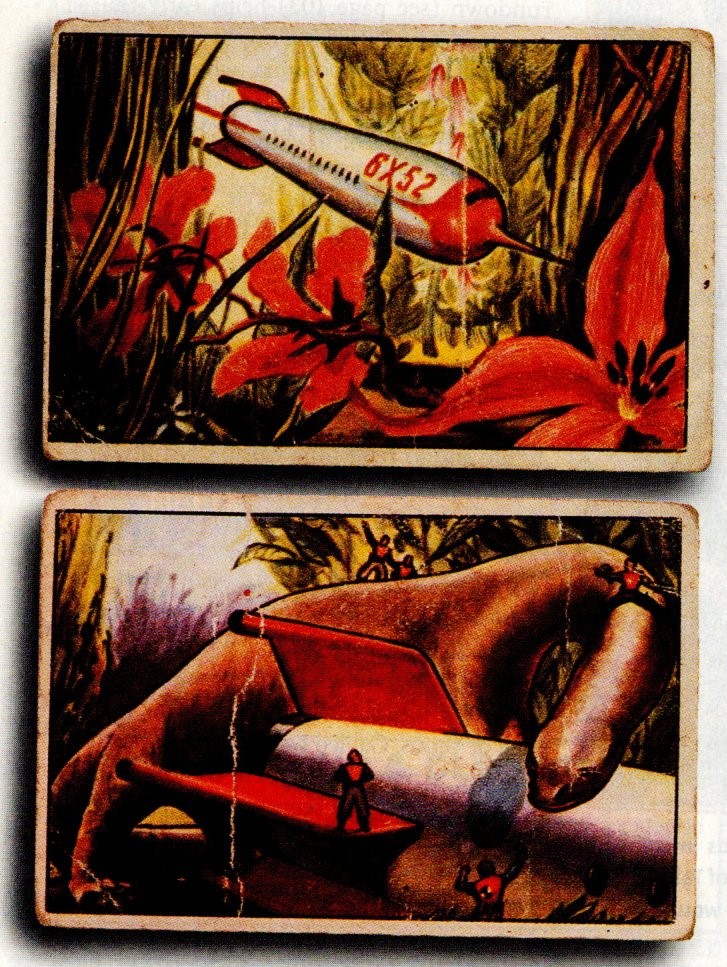
From The Martian-Flares Mystery (2001):
...On the night of December 8, 1951, one of Japan's leading planetary observers, Tsuneo Saheki of the Osaka Planetarium, was examining the tiny 5.3" disk of Mars through his 8-inch Newtonian at a magnification of 400x in fairly good seeing. At 21:00 Universal Time a "very small but extremely brilliant spot" suddenly appeared at the eastern end of the oasis Tithonius Lacus...
...Shortly after news of Saheki's observation reached Europe, British astronomy popularizer Patrick Moore received a telephone call from the science reporter of a famous London daily eater to hear his comments about "the atomic bomb that had gone off on Mars."
1953
...The era's most authoritative book on the subject of Martian life was The Green and Red Planet: A Physiological Study of the Possibility of Life on Mars, published by the University of New Mexico Press in 1953. The author, Hubertus Strughold, headed the department of space medicine at the U.S. Air Force School of Aviation Medicine at Randolph Air Force Base near San Antonio, Texas. Today he is remembered as the man who coined the term "astrobiology"... During the war Strughold had directed the Luftwaffe's Aeromedical Institute, an organization whose legacy included infamous experiments on human subjects...
[Mars Mania 1956 (2003)]
1954
Reports of an artificial bridge on the Moon, near the western shore of Mare Crisium, stemming from observations in 1953 by amateur astronomer John O'Neill, and corroborated by professional H P Wilkins. (See O'Neill's Bridge.)
An unusual short-lived brightening of Edom Promontorium, Mars, is observed by Tsuneo Saheki on 1st July [The Martian-Flares Mystery (2001)].
...In a matter of seconds the color of the feature changed from yellowish white to very bright pure white, and then back to yellowish white...
Reports of this event influence film and fiction.
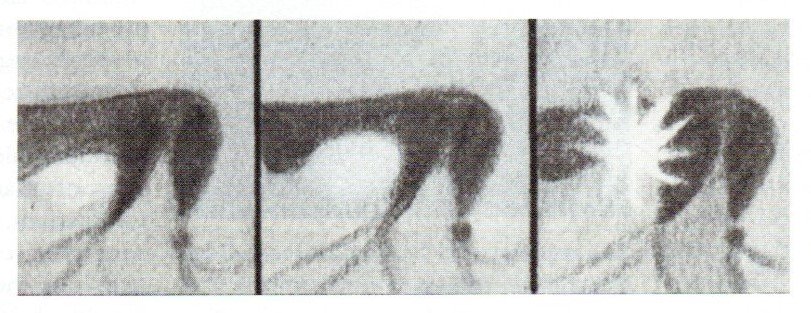 Tsuneo Saheki's observation, 1st July 1954.
Tsuneo Saheki's observation, 1st July 1954.1955
Earl C Slipher writing about the Martian canals in the September National Geographic:
...They do not meander like natural storm drainage. One runs for 1,500 miles without a bend - half the distance across the United States. Sometimes one canal will run straight through another, something no sensible river would do... To me, they suggest lines of vegetation along watercourses...
[Mars Mania 1956 (2003)]
1956
This year saw the last perihelic opposition of Mars before the Space Age. Despite the persistent lack of solid evidence, belief in the possibility of the "canals" and of intelligent life still persisted; and belief in the existence of lower Martian life in the form of vegetation appears still to have been the majority opinion at this time.
...Small wonder that observing the red planet held a fascination in 1956 that is hard for the present generation to even imagine. Few doubted that Mars was a living world, and it was hardly far-fetched to wonder, if only in passing, whether someone - or something - might be peering back at you. Astronomy clubs that offered the general public the opportunity to observe Mars through a telescope were often overwhelmed by the response. In Cleveland 7,000 visitors stood in line for hours for a ten-second peek through Warner and Swasey Observatory's 9½-inch refractor. Thousands of cars clogged roads leading to the Texas Astronomical Society's observatory near Dallas, where organizers grappled with a crowd of 15,000... [Mars Mania 1956 (2003)]
A particularly spirited defense that the canals of Mars represented a colossal feat of engineering was published in 1956 by Wells Alan Webb, a University of California research chemist. In Mars, the New Frontier, Webb argued that streaky patterns of inanimate origin, like the cracks produced in dried mud or on a piece of glazed porcelain, are characterized by three lines that radiate from common centers. In a spider's web four filaments extend from each intersection, while networks produced by intelligence of a high order - like the railroads of Ohio or the Martian canal network - feature a sizeable proportion of junctions with five or six lines radiating from each of them. [Mars Mania 1956 (2003)]
...On June 3, 1956, Mount Wilson Observatory astronomer Robert S. Richardson caught glimpses of "blue lines extending across the bright red regions like veins through some mineral" through the 60-inch reflector. Mars was still 75 million miles from Earth and presented a gibbous disk only 11.7 arcseconds in diameter, so Richardson was quite taken aback, recalling, "Several minutes passed before it occurred to me that these markings must be canals." (His admission was all the more remarkable because in 1954 he had written, "If wishful thinking could conjure up canals, I'd have seen them years ago.") [Mars Mania 1956 (2003)]
The article however goes on to relate how, on 10th August, Richardson saw Mars during half an hour of superb seeing at x3,200 maginification through the 100-inch, and the "canals" vanished into broken detail.
1957
In the second edition of his Flight Into Space, J N Leonard writes (p.154) - contradicting himself somewhat in the first two sentences, but overall expressing optimism as to the possibilities -
If intelligent beings do exist on Mars, they are certainly not at all like the dramatis personae of science fiction. They are just as likely to be disembodied brains like those coldly intelligent creatures in H.G.Wells' War of the Worlds. They may even be clever fungi with sedentary central intelligences directing the operations of far-reaching food-gathering organs. Not enough is known about Mars to give even the sketchiest idea of what its inhabitants are like and how they live - or whether they exist at all above the level of lichens or algae...
A cheery editorial in the July 1957 issue of Imaginative Tales remarks:
...if you're in your thirties or younger (happily we qualify!) you have an excellent chance of still being around when the canals of Mars are mapped by on-the-spot survey...
1958
Question number 182 in 1001 Questions Answered About Astronomy is asked and answered as follows:
What is the green on Mars? Probably vegetation. There is a seasonal change in the colour of the green regions in general, which follows to some extent the pattern of the seasonal colour change in vegetation on the Earth. The green areas on Mars are faint and delicate during the Martian spring; they grow much darker and, in some cases, almost a blue-green in the Martian summer; yellow and brown in the autumn, and a rather lifeless grey in the winter. The green regions are probably not covered with grass or trees, because they do not show the same sort of reflection of light that is produced by a chlorophyll plant. The vegetation, if such it is, is likely to be a sort of lichen which can grow in little or no soil, with a minimum of moisture and can withstand extremely cold temperatures. There is a theory, too, that the green substance is volcanic dust, whose drifting and shifting in the very light breezes that are all the rare atmosphere of Mars could produce, accounts for the colour change; however, few authorities support this idea.
1959
Apart from its phases, there is little to be seen on Venus... Some astronomers think that its surface is almost completely covered with sea...
[Our World in Space and Time, p.168]
1960
A terrific but brief excitement during a search for extraterrestrial intelligence, recounted in the article The Race to Epsilon Eridani (2001):
It was the early morning of April 8, 1960. The 26-meter radio dish of the National Radio Astronomy Observatory at Green Bank, West Virginia, was tracking Tau Ceti, a yellow dwarf star 11.9 light-years away... In the control room, a small group of radio astronomers and students sat around a chart recorder looking for intelligent signals from space. Unknown to the rest of the world, this was humanity's first serious effort to eavesdrop on alien civilizations.
For 29-year-old Frank Drake, team leader of Project Ozma... this was a dream come true...
Drake and his colleagues followed Tau Ceti until it set in the west. "Then we aimed the telescope toward our second target, Epsilon Eridani... We set up the recorders again and readied ourselves for the long wait. But scarcely five minutes passed before the whole system erupted. WHAM! A burst of noise shot out of the loudspeaker, the chart recorder started banging off the scale, and we were all jumping at once, wild with excitement."
As it turned out, the strong, pulsed signal had come from a passing plane...
Hopes about Mars expressed in Nine Planets, p165:
...As we have seen, most authorities now seem to be convinced that there is some form of low-grade plant life or vegetation living on Mars' surface...
After going on to argue that even the low-grade vegetation could not have evolved under the harsh Martian conditions of our time, but must have survived from an earlier epoch, the author swings into optimism, with paradoxical ingenuity - see the passage I have emphasized in bold:
...So if we accept the presence of plant life on Mars today, we have no choice but to agree that Mars is old, that is has changed radically and violently from the surface conditions that prevailed in the past, and that the life there now is all that is left of an extensive evolutionary progression on a dying planet. And if we accept these things, then we must accept the fact that intelligent life must have developed there - if intelligence is indeed a natural, inevitable step in the cosmic cycle of the Universe.
A bit later he suggests that the Martians may have left their native planet in order to find a more comfortable home among the stars!
Alan E Nourse (1928-92) was, as far as I am aware, a fairly well respected science writer, as well as a science-fiction writer known for the magnificent Brightside Crossing - one of the few great tales set on Mercury.
1960 [at a guess]
Patrick Moore in his autobiography describes an incident shortly before a Sky At Night broadcast on the question of Martian life, which is suggestive about the garbled hopes of journalists:
...At a public lecture just before our television programme I stated that "on Mars there may be lowly organisms, but nothing so advanced as a cabbage." One local newspaper gave a rather inaccurate report: "Astronomer claims that the nearest approach to Earth-type life on Mars is the growth of large cauliflowers." [Eighty Not Out (2003), p102] [note: the date Moore gives in his book is "1950"; this cannot be right since The Sky At Night only began in 1957. My guess is, "1950" is a misprint for "1960" so I am putting it under the latter date.]
From Artificial Satellites of Mars? by V I Cherednychenko:
It was known from the investigations of the American
scientist Sharples that, several decades after its dis-
covery, Phobos travelled along its orbit ahead of its cal-
culated position by an enormous magnitude - two and one
half degrees. This fact could only be explained as follows:
Phobos accelerated its motion when it got closer to the
surface of Mars. An analogous phenomenon is observed in
the artificial satellites of the earth when they get close
to the surface of the earth and decelerate in the terrestrial atmosphere.
The calculations of I. S. Shklovskii indicate that,
at this great acceleration, Phobos should fall on Mars
within 15 million years. This is a very short time in
comparison with the age of the planet Mars, which is several
billion years old.
What are the causes of this great acceleration or
Phobos? A satellite can draw closer to a planet and
simultaneously accelerate as a result of braking in the
interplanetary medium. However, the absence of such braking
of the more distant satellite, Deimos, excluded this
explanation. The extended atmosphere of Mars could also
brake the motion of Phobos. But the calculations of the
American scientist Whipple, made on the assumption that
Phobos was a solid heavenly body, did not confirm this conjecture.
The acceleration of Phobos could have been caused by
the tidal effect of the accumulation of liquid substances
on the planet's surface or by tides in the solid film of
the planet. Numerous observations, however, indicated a
lack of any large water reservoirs on Mars, and the calculations
of the English astronomer Jeffries proved that
tides in the solid film of Mars could explain only a very
small part of the observed acceleration of the satellite.
There was, therefore, only one assumption to be made,
i.e., that the satellites of Mars are hollow inside, with
a solid hard cover. Such satellites, however, would be of
a low compactness and experience considerable braking even
in the very rarefied atmosphere of Mars. Natural hollow
satellites, however, are an impossibility. The assumption
therefore follows that the satellites of Mars are artificial.
According to l.S. Shklovskii, Phobos and Deimos
are the relics of a former civilization of highly organized
beings on Mars, who, between two and three million years ago
(and this is the age of the satellites of Mars)
launched the artificial satellites of the planet. At that
time the atmosphere of Mars contained abundant oxygen and
there were large water reserves. Within several million
yeares, however, the oxygen and most of the water on Mars
disappeared, and at the same time the existence of tne
highly organized intelligent beings of the planet also
ceased.
Future fllghts of terrestrial cosmic rockets in the
direction of Mars will show the accuracy of these assumptions.
In the opinion of the Ki6V astronomers, I. S. Shklovskii
did not take into account the possibility that the braking
motion of Phobos resulted from contact with clouds of particles
of ashes, which could be discharged to great heights
during volcanic explosions on Mars. Nevertheless, the
assumptions of the Moscow astrophysicist are very interesting.
1962
The December 1951 observation of a "Martian flare" (q.v.) is included in a list of Martian features "most easily understood on the assumption that they are the product of intelligent beings", in an article in Science, by Frank Salisbury of the University of Colorado, who asks, with regard to the flare, "Was this volcanic activity, or are the Martians now engaged in debates about the long-term effects of nuclear fallout?"
[The Martian-Flares Mystery (2001)]
1963
Ben Bova speculates on the question of Jovian life in the March issue of Amazing Stories:
...Living in a murky sea under a cloudy atmosphere on a planet that is more than five times farther from the Sun than we are, it is very likely that the Jovian is blind. There would be little light, if any, to see by. Perhaps infrared sensors would be in order, but if the experience of earthly deep-sea dwellers counts for anything, the Jovians are more apt to depend on sonar-type echo locating systems, or sensitive feelers that respond to liquid wave motions, than on light receptors.
Finally, it must take an enormous amount of effort merely to move through the swirling, dense seas of a high-gravity planet. The Jovian might well be caught in a vicious circle in which he must constantly feed, so that he can maintain the energy to move about, so that he can find food, so that...
Later in the same article Bova turns to the question of Mars:
There are two important considerations to bear in mind about Mars - (1) it is practically certain that the annual color changes seen on the Red and Green Planet are due to vegetation; (2) the canals have been photographed. Concerning the second point, there is still no agreement among astronomers that the photographs show actual artificially-constructed canals; many observers insist that the camera is merely linking up a string of images that exist in a more-or-less straight line. This argument is akin to the old claim that the canals were optical illusions; now it is the camera, presumably, that is seeing things that are not really there. [See Science catching up for a highly relevant webcam image!] Within the next few years, though, orbiting telescopes will photograph Mars from above Earth's turbulent atmosphere. If the canals show up more sharply then, the "optical illusion" argument should be permanently shattered...
1969
May:
The British magazine Science Journal 's May issue (which I bought when it came out), on sale for five shillings, was a special issue, "Man on the Moon". On page 86 could be found this thrilling diagrammatic forecast of lunar exploration in the 1970s:
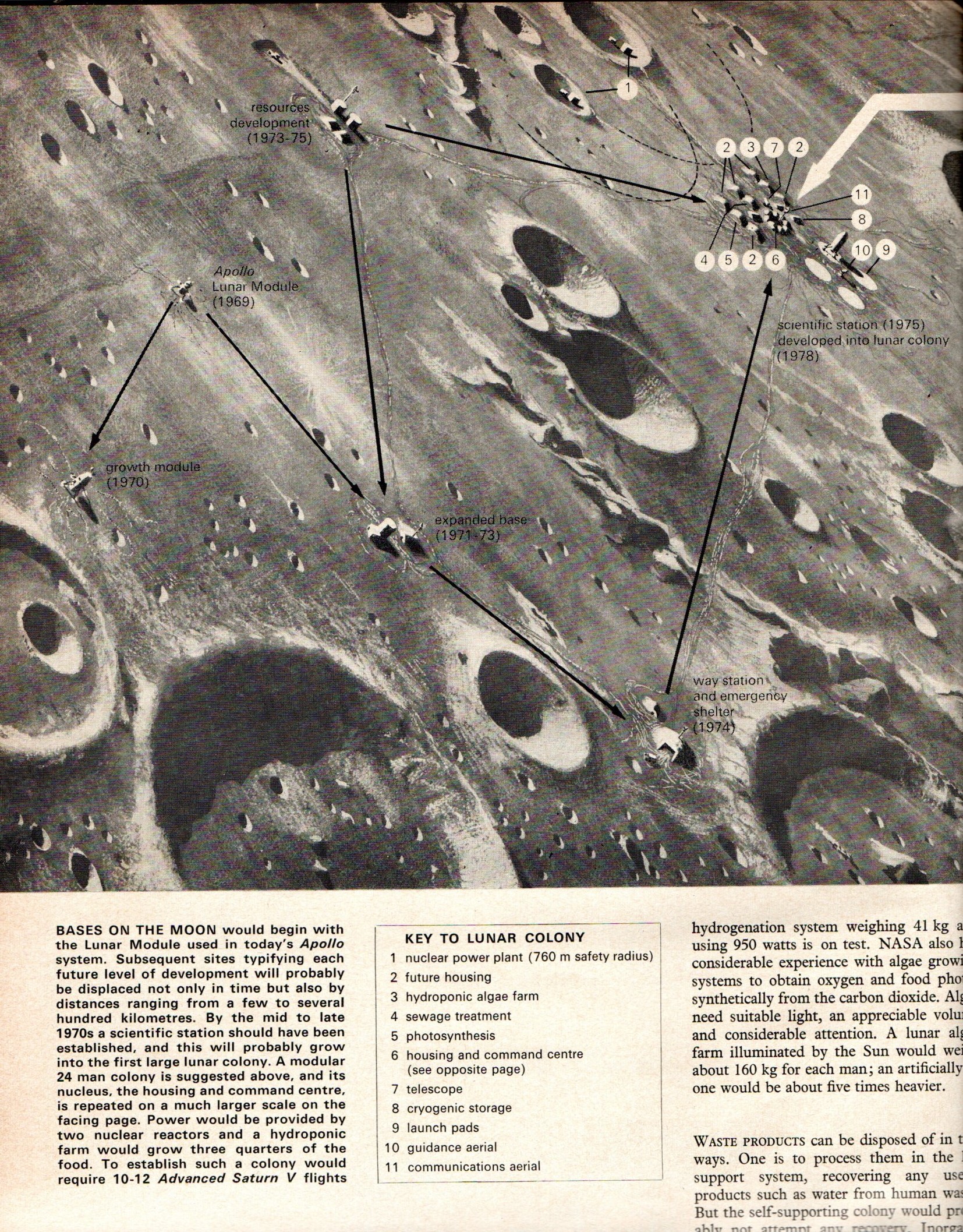
My fifteen-year-old self could hardly wait for 1978 and the Lunar Colony!
On page 87 of the Journal, opposite to the above diagram on page 86 and referring to its top right, is a detailed scheme of the "nucleus of a 24-man lunar colony".
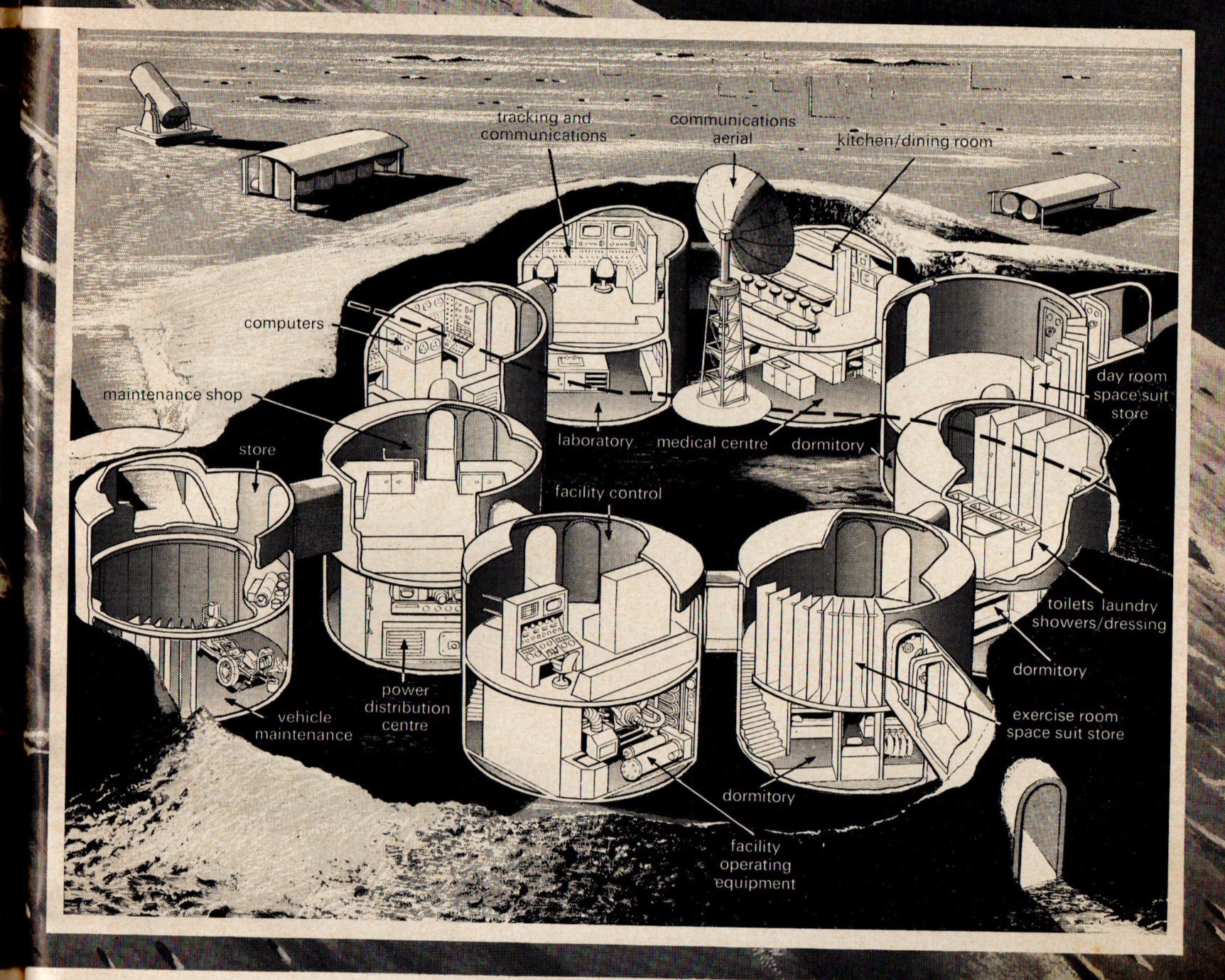
July:
The existence of native lunar life (in microbial form) was still considered a possibility by the Apollo 11 team - which is why the returning astronauts were subjected to a 21-day quarantine!
Some expectations alive in 1969 can be read from The Invasion of the Moon 1969: The Story of Apollo 11:
...The administrator of NASA, Thomas Paine, has already said that the first space passengers will be able to visit the moon in the 1980s... [ p162]
..."We are much closer to Mars today than we were to the moon eight years ago," said NASA administrator Thomas Paine recently, giving hope to those who would like to see a manned expedition to Mars in the 1980s. 1985 is a favoured date but it could be sooner... [p167]
And a cute little passage on p171 shows that at least one popular science author as late as 1969 was still blissfully unaware of the disproof of Mercury's Twilight Belt:
...Mercury... always presents the same face to its parent so that a spacecraft would be directed to the terminator, the edge of the planet where the light and dark sides meet...
1970
In an editorial in the March issue of Analog, John W Campbell expresses a fairly optimistic view of life on Mars, despite the results from Mariners 4, 6 and 7, and despite the article's title "Good-bye Barsoom":
....We're not talking abouot terrestrial plants gasping for life on Mars - we're discussing a form that might have evolved there during the last 3,000,000,000 or 4,000,000,000 years. A life form doesn't "struggle for life" for three or four gigayears; it learns to love those conditions... or it's dead.
The discussions I've seen on possible life forms on Mars have, in my personal opinion, been foolishly conservative - they've lacked imagination...
...we're not talking about terrestrial-type plants. Let's design plants that are meant for a dessicated region with 180° daily temperature swings.
Obviously, if the plants are to stay active, they need an effective antifreeze in their metabolism. Water is present on Mars - it's in short supply, but it's there. Since water is far and away the most active solvent possible, we'll assume the plants of Mars use water as a metabolite solvent. How they get it we can figure out later.
To keep it from freezing at -100° or so, we need antifreeze. Fine! And that's easy; practically all the anti-freeze solutions used on Earth are simple organics that plants either normally do, or could, produce. Glycerin is almost universal in plant and animal metabolism. Ethylene glycol, ethyl and methyl alcohol are widely used antifreeze additives; ethyl alcohol is normally produced by plants called yeasts; methanol, "wood alcohol", is also readily produced by living cells. Ethylene glycol doesn't seem to be very popular with terrestrial plants - but there's no reason to doubt Martian plants couldn't use it conveniently...
...
1971
12th November: symposium at Caltech, the panel including Ray Bradbury, Arthur C Clarke, Carl Sagan, Bruce Murray and Walter Sullivan; the subject being the planet Mars, on the occasion of the imminent arrival of the Mariner 9 probe into Martian orbit.
Bradbury is recorded saying "I don’t know what in the hell I’m doing here. I’m the least scientific of all the people up on the platform here today...I was hoping, that during the last few days, as we got closer to Mars and the dust cleared, that we’d see a lot of Martians standing there with huge signs saying, ‘Bradbury was right...’” [Mars and the Mind of Man (1973)]
1972
I have not found an explicit reference but I am morally certain that when the first image of Angustus Labyrinthus was received, the idea must have occurred to the Mariner 9 team, at least briefly, that they had discovered a real Martian city.
The image shown below is not from Mariner 9 but from much later. (https://www.dlr.de/en/latest/news/2024/angustus-labyrinthus-the-inca-city-at-mars-south-pole.) Still, the Mariner 9 team were sufficiently impressed to dub the formation "Inca City". And at least to some of them I reckon there must have been a brief frisson of excitement, of hope...
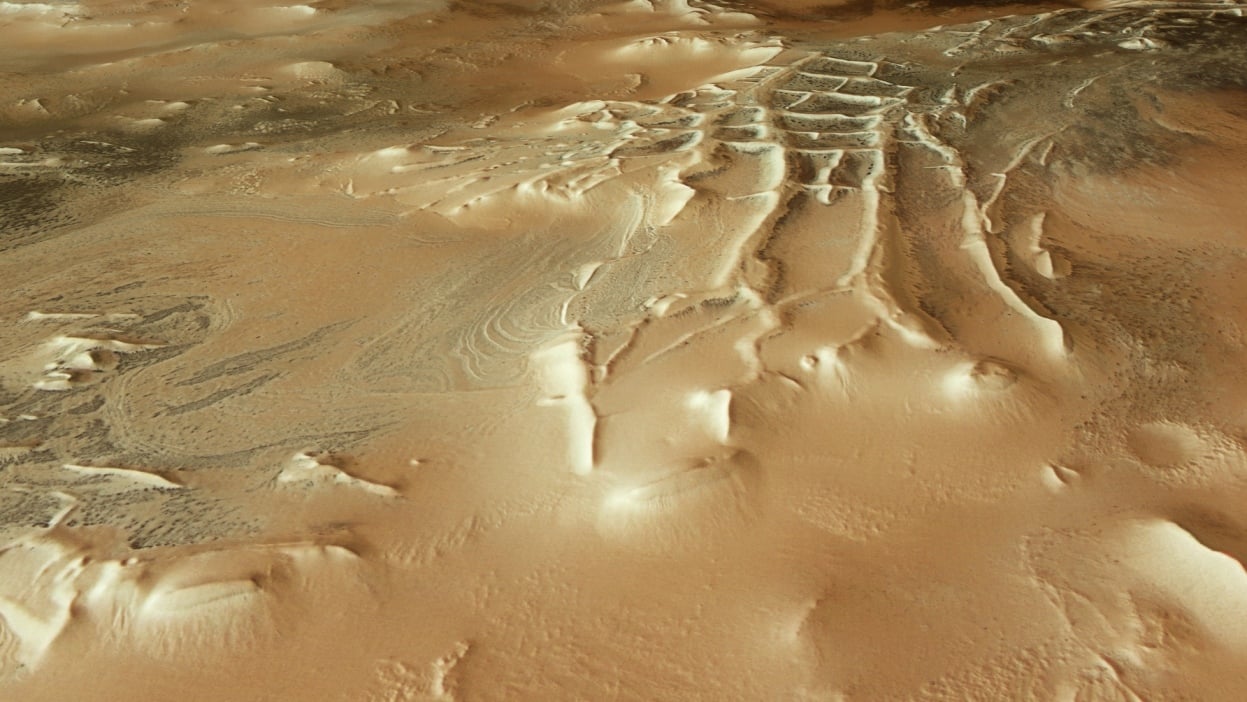 in the Mare Australe region, near Mars' south pole... if this doesn't show a ruined city, I don't know what does!
in the Mare Australe region, near Mars' south pole... if this doesn't show a ruined city, I don't know what does!Another reference from the year 1972: for the Chicago Tribune magazine Arthur C Clarke wrote an essay "The Next Twenty Years", which was collected in The View from Serendip (1978).
...by 1992, if the first men are not on Mars, they will be preparing to go there...
And as regards the Moon:
Twenty years from now, men will be living there, and the first child may well have been born in some lunar colony...
[Er - what happened to all this?]
1976
George H Leonard's Somebody Else is On the Moon tries to argue that NASA imagery contains evidence that the Moon is inhabited.
1977
The "Wow! signal" from space.
1984
300 participants held a NASA-sponsored lunar conference in late October entitled "Lunar Bases and Space Activities of the 21st Century".
...Optimists voiced their confidence that a Moon base could be established as early as 2001, and there seems to be nothing inherently impractical in such a timetable...
[The Moon - A Second Time Around?]
1999
...The consensus of JPL's planning team was that an "aggressive" Mars-exploration strategy could place astronauts on the planet in July 2014. Alternatively, a "paced" strategy would have a human crew leave Earth in 2018 and arrive on Mars in July 2019 - the 50th anniversary of Apollo 11's lunar landing...
[A Master Plan for Mars]
2287
On 28th August, Mars will be even closer than at the opposition of 2003 when it approached to within 34,646,418 miles. If there are still amateur telescope-users on Earth in 2287, they should be looking forward to the day...
Note with regard to an OSS Diary entry titled Atolls in the Lunar Seas, about some fascinating speculations by Charles Babbage, the nineteenth-century "father of the computer": I would very much like to put a reference to Babbage's thoughts onto this page's timeline, but I can't find a date for them; Oliver Morton's book, from which I learned of them, sadly gives no references. I'd welcome the information from any reader who can provide it.
Svante Arrhenius, The Destinies of the Stars (1918); Ben Bova, "Intelligent Life in Space" (Amazing Stories, March 1963); Robert Burton, The Anatomy of Melancholy (1621); John W Campbell, "Other Eyes Watching" (Astounding Stories, February 1937); V I Cherednychenko, "Artificial Satellites of Mars?" (1960); Michael J Crowe, The Extraterrestrial Life Debate 1750-1800 (1986) = TELD; "The Surprising History of Claims for Life on the Sun" (Journal of Astronomical History and Heritage (ISSN 1440-2807), Vol. 14, No. 3, p. 169-179
(2011); Leonard David, "A Master Plan for Mars" (Sky & Telescope, April 1999); Thomas Dobbins and William Sheehan, "The Martian Flares Mystery" (Sky & Telescope, May 2001, p115-123); "Mars Mania 1956" (Sky & Telescope, June 2003, p28-33); "The Canals of Mars Revisited" (Sky & Telescope, March 2004, p114-7); Esco publishing corp., Our World in Space and Time (1959); John Ellard Gore, Worlds of Space (1894); Harper and Rowe (publishers), 1973: Mars and the Mind of Man (a record of the 12 November 1971 symposium at Caltech); John Herschel, A Treatise on Astronomy (1933); Richard Holmes, The Age of Wonder (2008); William Graves Hoyt, Lowell and Mars (1976); E Hubble, "The 200-Inch Telescope and Some Problems It May Solve" (Publications of the Astronomical Society of the Pacific, vol. 59, no. 349, p.153 (1947)); E C Krupp, "The Camera-Shy Planet" (Sky & Telescope, October 1999, p.93-5); Johathan Norton Leonard, Flight into Space (1953, 1957); Percival Lowell, Mars and its Canals (1906); H Macpherson, "Camille Flammarion", Popular Astronomy, vol.33, p654 (1925); R J Manning, "John Elliott and the inhabited Sun" (Annals of Science vol. 50 (1993), issue 4); K P Marshall and M P Mobberley, "The Lunar Crater Plato", (Journal of the British Astronomical Association, vol. 96 (1986), pp. 156-165); Patrick Moore, "The Linné Controversy: A Look into the Past" (Journal of the British Astronomical Association, Vol. 87 (1977), p363-8);
"The Mapping of Mars" (Presidential Address to the British Astronomical Association, 1983); Eighty Not Out: The Autobiography (2003); Alan E Nourse, Nine Planets (1960); James S Pickering, 1001 Questions Answered About Astronomy (1958); Peter Ryan, The Invasion of the Moon 1969: The Story of Apollo 11 (1969); Govert Schilling, "The Race to Epsilon Eridani" (Sky & Telescope, June 2001); G M Searle, "Are the Planets Habitable?" (Astronomical Society of the Pacific Publications, 2 (1890)); William Sheehan, The Immortal Fire Within: the life and work of Edward Emmerson Barnard (1995); Alfred, Lord Tennyson, Locksley Hall: Sixty Years After (1886); Mark Washburn, "The Moon - A Second Time Around?" (Sky & Telescope, March 1985); Charles A Wood, "Auzout: A Minor Crater and Some Big Ideas" (Sky & Telescope, February 2004, p.118) ; William Wordsworth, "Peter Bell, A Tale" (1798, published 1819).
